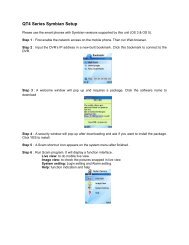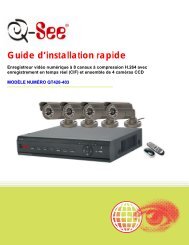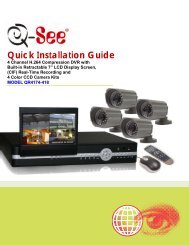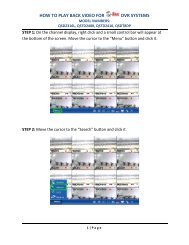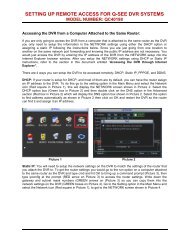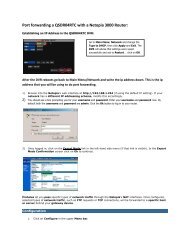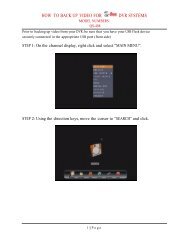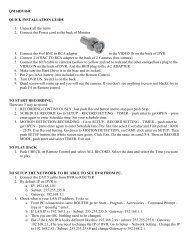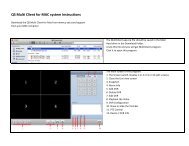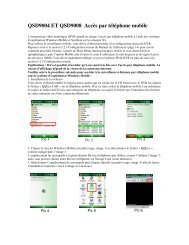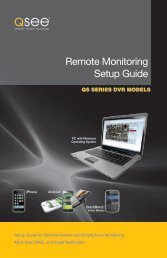User Manual - Q-See
User Manual - Q-See
User Manual - Q-See
You also want an ePaper? Increase the reach of your titles
YUMPU automatically turns print PDFs into web optimized ePapers that Google loves.
A gray map icon can be drawn to the corresponding position in the map on the right and set it<br />
as a sub-map of the current map, or click the gray map icon on the left by right key and select<br />
‘Open’ to build a new map. You can also click the blue map icon on the left by right key, and<br />
select ‘Rename’ to change the name of the map or select ‘Close’ to cancel this map. The map<br />
tree can only support three levels of maps and submaps.<br />
7.4 USER CONFIGURATION<br />
<strong>User</strong> accounts, privileges and passwords can be added, changed or deleted in this<br />
menu. After installing the SuperDVR program, it will automatically create an administrator<br />
account with the user name SYSTEM with no password. <strong>User</strong>s can use this name to log in the<br />
system and Add, Edit or Delete users’ parameters.<br />
USING THE E-MAP<br />
To view the E-map during monitoring, click on its icon on the right side of the Main<br />
Display Interface.<br />
When a channel alarm is triggered, the camera icon will flash a yellow alarm signal. Select<br />
‘Auto Show’, in case of an accidental alarm, an alarming screen will pop out automatically and<br />
you can know about the alarming position immediately. Right-click on the camera to bring up<br />
its feed immediately.<br />
Alternately, you can enable Auto Show to bring up the E-map when you’re in another viewing<br />
mode.<br />
PICTURE 7-13<br />
USER RIGHTS<br />
Select a user in the <strong>User</strong> Configuration area, and<br />
click Edit to enter the Edit <strong>User</strong> area<br />
<strong>User</strong>s can edit user’s password and rights here, but<br />
not the user name.<br />
The system offers three kinds of rights:<br />
Administrator: this user has the right to change all<br />
the settings and playback. This user also has the<br />
right to assign users power user rights and normal<br />
user rights.<br />
Power <strong>User</strong>: This type of user is authorized by the<br />
administrator. The administrator assigns rights to<br />
power users by checking boxes in the Power <strong>User</strong><br />
list.<br />
Normal <strong>User</strong>: Normal user’s rights are also<br />
assigned by the administrator. They have the same<br />
list of available rights as Power <strong>User</strong>s. However,<br />
whether they can possess a right is be decided by<br />
the administrator. Only if the administrator assigns<br />
that right, will they have the right. For example, if<br />
Basic Configuration is checked, the Normal <strong>User</strong><br />
can access these functions.<br />
PICTURE 7-14<br />
PICTURE 7-15<br />
CHAPTER 7 SYSTEM SETTINGS<br />
NOTE! Administrators can change and authorize rights to Power <strong>User</strong>s and<br />
Normal <strong>User</strong>s, but they cannot change or authorize other Administrators’<br />
rights.<br />
42 43




